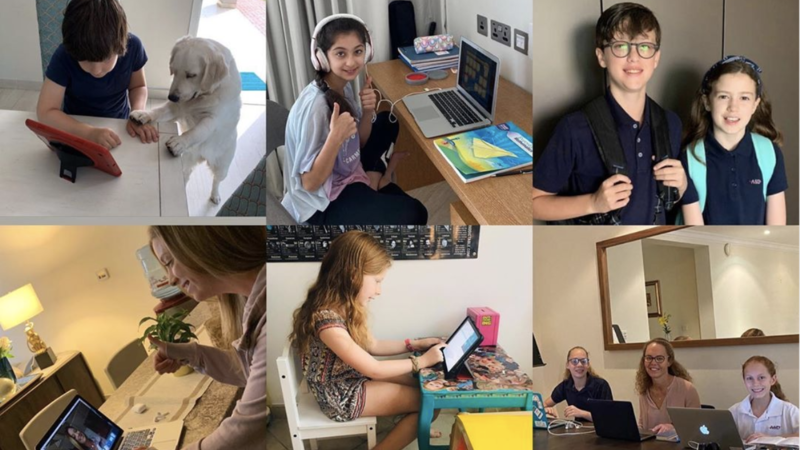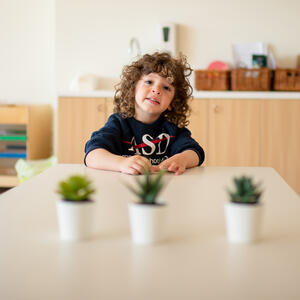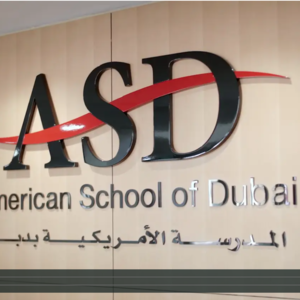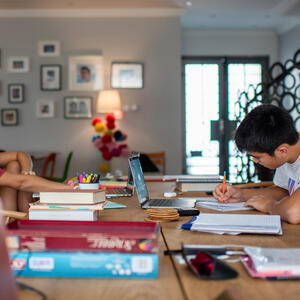
by Dr. Paul Richards, ASD Superintendent and father of two distance learning students.
“We must be willing to change our belief system, let the past slip away, expand our sense of now, and dissolve the fear in our minds.”—Gerald G. Jampolsky (American Psychiatrist, age 95)
The COVID-19 pandemic has placed unprecedented stress on schools and their ability to deliver their programs. Educators around the world have responded admirably to the challenge, as have their students and communities. HH Sheikh Mohammed bin Rashid al Maktoum told the nation this week, “Our education and learning drive will never stop, no matter the circumstances.” This is truth.
Distance learning has started in earnest at the American School of Dubai (ASD). Before it launched, significant thought and research went into developing a comprehensive Continuity of Learning (COL) plan. This included gathering valuable testimonials from sister schools in Asia, who have been living in this present reality for several weeks now.
Distance learning is not new to the education sector. Fully online schools have supported home-schooled students for decades, though maintaining quality of product has been a challenge for the online industry, as many providers simply replicate a passive, teacher-driven learning environment (think correspondence courses of a past era).
However, there are several exemplary providers of distance education, with the Global Online Academy (GOA) leading the pack (of which ASD is a member school). For nearly a decade, the GOA has leveraged a network of dozens of the finest American and international independent schools, enlisting teachers from these schools to offer a progressive, student-driven, networked learning experience.
Hallmarks of GOA’s pedagogy, each of which can be seen in ASD’s COL plan, include:
- Maintaining strong online learning communities that foster connections and relationships.
- Reimagining learning, rather than replicating what would have been offered in a brick-and-mortar classroom. Doing the latter has proven unsustainable to teachers and students alike.
- Finding a balance between asynchronous learning (which allows students to self-pace their work) and synchronous learning (which fosters connection).
- Using assessments that allow students to demonstrate their learning through application of the content, rather than a regurgitation of facts.
An ASD student’s day (let’s use Yasmine, Grade 8, as an example) starts in the morning with her logging into an online learning platform—Google Classroom—and receiving her asynchronous assignments for the day. She records this in a planner provided to her by the middle school. Yasmine is able to access ASD’s teachers, counselors, and administrators during the daily “office hours”, which leads up to her lunchtime break. Yasmine can choose to consult with a teacher via Google Hangouts, join a synchronous activity with her math class, or start a video chat with her classmates. Yasmine has accessed her learning community to get what she needs but has done so virtually. She is owning her learning and building agency.
After a healthy lunch and some fresh air, Yasmine’s afternoon is spent continuing to work on her assignments. This may involve further consultation with her teachers. Once finished with her schoolwork, her attention turns to a balance of healthy and fun activities, time with family, and additional home learning through accessing engaging web resources, such as this one from World of Humanities, which links Minecraft and History. Yasmine retires for the night at her normal bedtime hour with an increased sense of confidence (from her successful self-management of her learning). She misses her friends, and the fun of extra-curricular activities, but she is in a good and safe place.
ASD will need to be adaptive if its distance learning program becomes a long-term endeavor. It may need to adjust the balance between asynchronous and synchronous activities for some teachers. It may need to re-engage students who lag in their responsibilities. In some cases, teachers may be asked to draw back the amount of work assigned, and in other cases, they will be asked to increase their students’ workload. We will do so by both monitoring online activity, and by routinely gathering feedback from students and their parents. Adaptation is critical due to the inherent challenges of the sudden shift from campus learning to distance learning.
It is not just our society that may fundamentally change after the coronavirus pandemic subsides. Education and the future of schooling will change forever, and this should be seen as a good thing!
ASD is confronting many challenges already, only a few days into distance learning:
- Managing some parents’ inclination to prefer excessive structure and traditional methodology (e.g. video lecturing). We are reminding parents of ASD’s student-centered approach to teaching and learning.
- Finding a proper balance of screen time and being unplugged. We are asking parents to track and manage total screen time for their children.
- Fostering simplicity by asking teachers to avoid introducing new, cumbersome tools to the learning environment (just hosting synchronous activities and creating video content have been overwhelming for many).
- Connecting with at-risk students who will find distance learning especially challenging, or those who need mental health support.
- Managing the countless WhatsApp groups in our community. It has been said that “anxiety loves company”, and this medium thrives on anxiety and conflict. These online forums do not seem to be serving people’s mental health well.
It is not just our society that may fundamentally change after the coronavirus pandemic subsides. Education and the future of schooling will change forever, and this should be seen as a good thing! In this new world, after experiencing a successful distance learning experience, students will have cultivated greater ownership and agency in their learning, and developed more self-awareness of themselves as learners. Teachers will have gained additional skills, incorporating asynchronous activities into their instruction, thus creating more of a hybrid learning experience for students (i.e. teachers will finally relinquish a substantial degree of control). Parents will realize the potential of home learning (beyond worksheets), develop greater empathy for teachers, and see the home-school partnership grow stronger. Families will flourish and bonds will grow deeper. Communities will thrive at a new level.
Finally, it behooves all of us in this distressing and scary time to find the beauty in the ugly or the difficult, for beauty is always around us if we take the time to look for it. Antoine de Saint-Exupery in The Little Prince wrote, “Here is my secret. It is very simple: It is only with the heart that one can see rightly, what is essential is invisible to the eye.” Finding beauty is an essential endeavor, and it is best done through being present and noticing the little things, such as a child discovering something new and exciting, or watching creativity spring up from unexpected sources, or bonding with someone who you lost touch with. Have you noticed the abundance of flowers blooming and birds singing across Dubai? Finding beauty leads to happiness and contentment, and will get us through this crisis.
ASD greatly appreciates the Knowledge and Human Development Authority (KHDA) for sharing these moments of beauty each day via Twitter, and its role in galvanizing and supporting Dubai’s private schools to meet this challenge head-on. ASD is also extremely thankful for the UAE’s proactive and decisive efforts to make our communities safe and to keep the learning going. #InThisTogetherDubai
- Virtual Learning
- COVID-19



